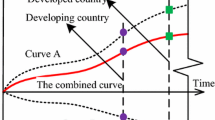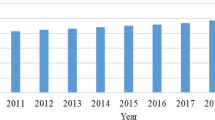Abstract
Energy savings can be treated as an indicator to reveal the effectiveness of energy efficiency task (EET) in the building sector, especially in the public buildings. However, evaluating the values of energy savings in public buildings (ESPB) was challenged by the missing data sources and inadequate tools in China. To overcome these problems, this study applied an extended Logarithmic Mean Divisia Index model to examine the contributions of different impact factors affecting the public building energy consumption (PBEC) and further evaluated the ESPB values during the 10th–12th Five-Year Plan (FYP) periods in China. Results included three aspects: (1) Absolute values of the contribution of the adjusted PBEC intensity to PBEC denoted the ESPB values in China. (2) Total values of ESPB were 99.9 Mtce during the 10th–12th FYP periods of China. Concretely, the ESPB values during the three FYP periods were as follows: 71.091 Mtce (the 12th FYP period), 19.075 Mtce (the 11th FYP period), and 9.734 Mtce (the 10th FYP period). (3) Effective EET of public buildings was a strong support for the rapidly growing ESPB during the three FYP periods. Furthermore, this study suggested that China should issue the official data on energy consumption in the building sector as quickly as possible, and this action would deeply help the government design targeted plans and policies for the future EET in the building sector.






Similar content being viewed by others
Abbreviations
- PBEC:
-
Public building energy consumption
- \(E\) :
-
Public building energy consumption (PBEC) in China
- ESPB:
-
Energy savings in public buildings
- \(P\) :
-
Population size in China
- \(U\) :
-
Urbanization level in China
- \(f\) :
-
Floor space per capita of public buildings in China
- \(e\) :
-
PBEC intensity in China
- \(e_{{{\text{ad}} .}}\) :
-
Adjusted PBEC intensity in China
- \(L_{\text{s}}\) :
-
Service level of public buildings in China
- \(L_{\text{P}}\) :
-
Per capita level of PBEC in China
- \(\varepsilon\) :
-
Conversion index between \(L_{\text{s}}\) and \(L_{\text{P}}\)
- LMDI:
-
Logarithmic Mean Divisia Index
- \(\Delta E_{P}\) :
-
Contribution of \(P\) to \(E\)
- \(\Delta E_{U}\) :
-
Contribution of \(U\) to \(E\)
- \(\Delta E_{f}\) :
-
Contribution of \(f\) to \(E\)
- \(\Delta E_{{L_{\text{s}} }}\) :
-
Contribution of \(L_{\text{s}}\) to \(E\)
- \(\Delta E_{{{\text{e}}_{{{\text{ad}} .}} }}\) :
-
Contribution of \(e_{{{\text{ad}} .}}\) to \(E\)
References
Ang BW (2005) The LMDI approach to decomposition analysis: a practical guide. Energy Policy 33(7):867–871
Ang B (2015) LMDI decomposition approach: a guide for implementation. Energy Policy 86:233–238
Berardi U (2017) A cross-country comparison of the building energy consumptions and their trends. Resour Conserv Recycl 123:230–241
Cai W, Liu F, Zhou X, Xie J (2016) Fine energy consumption allowance of workpieces in the mechanical manufacturing industry. Energy 114:623–633
Cai W, Liu F, Zhang H, Liu P, Tuo J (2017a) Development of dynamic energy benchmark for mass production in machining systems for energy management and energy-efficiency improvement. Appl Energy 202:715–725
Cai W, Liu F, Xie J, Liu P, Tuo J (2017b) A tool for assessing the energy demand and efficiency of machining systems: energy benchmarking. Energy 138:332–347
Cai W, Liu F, Xie J, Zhou X (2017c) An energy management approach for the mechanical manufacturing industry through developing a multi-objective energy benchmark. Energy Convers Manag 132:361–371
Cai W, Liu F, Dinolov O, Xie J, Liu P, Tuo J (2018) Energy benchmarking rules in machining systems. Energy 142:258–263
CABEE (2016) Chinese building energy consumption report. In: Cai WG (ed) Beijing, PR China
Choi K-H, Oh W (2014) Extended Divisia index decomposition of changes in energy intensity: a case of Korean manufacturing industry. Energy Policy 65:275–283
Ehrlich PR, Holdren JP (1971) Impact of population growth. Science 171(3977):1212–1217
Fujii M, Fujita T, Dong L, Lu C, Geng Y, Behera SK et al (2016) Possibility of developing low-carbon industries through urban symbiosis in Asian cities. J Clean Prod 114:376–386
Kong X, Lu S, Wu Y (2012) A review of building energy efficiency in China during “Eleventh Five-Year Plan” period. Energy Policy 41(Supplement C):624–635
Liang H, Tanikawa H, Matsuno Y, Dong L (2014) Modeling in-use steel stock in China’s buildings and civil engineering infrastructure using time-series of DMSP/OLS nighttime lights. Remote Sens 6(6):4780–4800
Liang L, Hu X, Tivendale L, Liu C (2017) The log mean divisia index based carbon productivity in the Australian construction industry. Constr Econ Build 17(3):68–84
Lin B, Liu H (2015) CO 2 emissions of China’s commercial and residential buildings: evidence and reduction policy. Build Environ 92:418–431
Liu Z, Xu W, Zhai X, Qian C, Chen X (2017a) Feasibility and performance study of the hybrid ground-source heat pump system for one office building in Chinese heating dominated areas. Renew Energy 101:1131–1140
Liu Z, Li H, Liu K, Yu H, Cheng K (2017b) Design of high-performance water-in-glass evacuated tube solar water heaters by a high-throughput screening based on machine learning: a combined modeling and experimental study. Sol Energy 142:61–67
Lynn KP, Nina K, Nan Z, David F, Ali H, Hongyou L, et al. (2017) Reinventing fire: China—the role of energy efficiency in China’s roadmap to 2050. In: Conference reinventing fire: China—the role of energy efficiency in China’s roadmap to 2050, Presqu’ile Giens, Hyeres, France
Ma M, Yan R, Cai W (2017a) An extended STIRPAT model-based methodology for evaluating the driving forces affecting carbon emissions in existing public building sector: evidence from China in 2000–2015. Nat Hazards 89(2):741–756
Ma M, Yan R, Du Y, Ma X, Cai W, Xu P (2017b) A methodology to assess China’s building energy savings at the national level: an IPAT-LMDI model approach. J Clean Prod 143:784–793
Ma M, Yan R, Cai W (2017c) A STIRPAT model-based methodology for calculating energy savings in China’s existing civil buildings from 2001 to 2015. Nat Hazards 87(3):1765–1781
McNeil MA, Feng W, du Can SdlR, Khanna NZ, Ke J, Zhou N (2016) Energy efficiency outlook in China’s urban buildings sector through 2030. Energy Policy 97:532–539
Mi Z, Meng J, Guan D, Shan Y, Song M, Wei Y-M et al (2017) Chinese CO 2 emission flows have reversed since the global financial crisis. Nat Commun 8(1):1712
MOHURD_of_PRC (2012) “12th Five-year” Building energy-saving special Plan
MOHURD_of_PRC (2017) “13th Five-year” building energy-saving and green building development plan
Shao S, Yang L, Gan C, Cao J, Geng Y, Guan D (2016) Using an extended LMDI model to explore techno-economic drivers of energy-related industrial CO 2 emission changes: a case study for Shanghai (China). Renew Sustain Energy Rev 55:516–536
Shuai C, Chen X, Wu Y, Tan Y, Zhang Y, Shen L (2018) Identifying the key impact factors of carbon emission in China: results from a largely expanded pool of potential impact factors. J Clean Prod 175:612–623
Wang L, Long R, Chen H (2017a) Study of urban energy performance assessment and its influencing factors based on improved stochastic frontier analysis: a case study of provincial capitals in China. Sustainability 9(7):1110
Wang Y, Liu H, Mao G, Zuo J, Ma J (2017b) Inter-regional and sectoral linkage analysis of air pollution in Beijing–Tianjin–Hebei (Jing-Jin-Ji) urban agglomeration of China. J Clean Prod 165:1436–1444
Wei W, He L-Y (2017) China building energy consumption: definitions and measures from an operational perspective. Energies 10(5):582
Yan R, Ma M, Pan T (2017) Estimating energy savings in Chinese residential buildings from 2001 to 2015: a decomposition analysis. J Eng Sci Technol Rev 10(1):107–113
Ye H, Ren Q, Hu X, Lin T, Shi L, Zhang G et al (2018) Modeling energy-related CO2 emissions from office buildings using general regression neural network. Resour Conserv Recycl 129:168–174
Acknowledgements
This study was supported by the Fundamental Research Funds for the Central Universities of PR China (106112017CDJXSYY0001-KJYF201706 and 2017CDJSK03YJ05), the Graduate Research and Innovation Foundation of Chongqing, China (CYB17027), and the Fundamental Research Funds for the Central Universities of PR China (2017CDJSK03XK01).
Author information
Authors and Affiliations
Corresponding author
Appendices
Appendix A
On the basis of the original LMDI decomposition proposed by Ang (2015), the value of PBEC changes (i.e., \(\Delta E\)) during a period of \(\Delta T\) can be indicated as shown below.
where \(L\) represents the \(L\left( {E|_{T} ,E|_{0} } \right)\), which indicates the logarithm mean of two positive variables, as demonstrated in Eq. (A–7).
Following the definition of ESPB, the improved approach to evaluating ESPB values based on Eq. (1) is as follows.
where \(\Delta E_{j} |_{0 \to T} \in \left\{ { \Delta E_{P} , \Delta E_{U} , \Delta E_{f} , \Delta E_{{L_{s} }} , \Delta E_{{e_{{{\text{ad}}.}} }} } \right\}\), and
Appendix B
As indicated in Sect. 2.3, the data on PBEC and floor spaces of public buildings in China were collected from Chinese Building Energy Consumption Report (2016) (CABEE 2016), which provided the detailed time-series data on national building energy consumption in China. Furthermore, this report also issued a series of building-related statistical indexes (e.g., floor spaces of different types of civil buildings). The aforementioned data are illustrated in Fig. 7.

Sources: CABEE (2016)
Trends of civil building energy consumption (\({\text{PE}}\), \({\text{RE}}_{1}\), and \({\text{RE}}_{2}\)) and floor spaces of civil buildings (\({\text{PF}}\), \({\text{RF}}_{1}\), and \({\text{RF}}_{2}\)) during the 10th–12th FYP periods in China. Notices: \({\text{PE}}\)—Public building energy consumption in China; \({\text{RE}}_{1}\)—Residential energy consumption in urban China; \({\text{RE}}_{2}\)—Residential energy consumption in rural China; \({\text{PF}}\)—Floor spaces of public buildings in China; \({\text{RF}}_{1}\)—Floor spaces of residential buildings in urban China; \({\text{RF}}_{2}\)—Floor spaces of residential buildings in rural China. URL: http://www.efchina.org/Attachments/Report/report-20170710-1.
Rights and permissions
About this article
Cite this article
Ma, M., Yan, R. & Cai, W. Energy savings evaluation in public building sector during the 10th–12th FYP periods of China: an extended LMDI model approach. Nat Hazards 92, 429–441 (2018). https://doi.org/10.1007/s11069-018-3210-6
Received:
Accepted:
Published:
Issue Date:
DOI: https://doi.org/10.1007/s11069-018-3210-6




